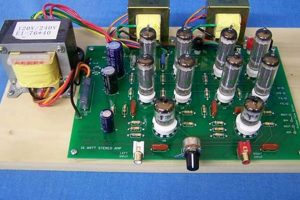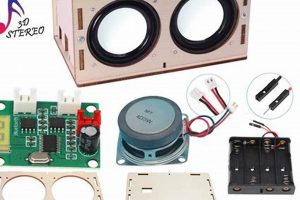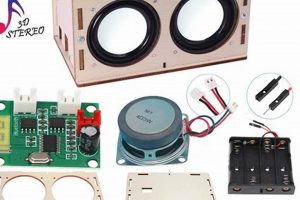A do-it-yourself chroming system provides the means to apply a reflective, metallic finish to various surfaces outside of a professional setting. Such systems typically include a chemical solution, application tools, and instructions designed for use by individuals without specialized training. An example includes applying a mirrored coating to automotive trim or household objects.
The appeal of these systems lies in the potential for cost savings and customization compared to professional services. Historically, achieving a chrome-like finish required complex electroplating processes. Modern systems offer a simplified alternative, albeit with varying degrees of durability and finish quality. The emergence of these kits has broadened access to decorative metal coatings, empowering individuals to enhance aesthetics with a metallic sheen.
The following sections will detail the components of typical systems, outline preparation steps, describe the application process, address common challenges, and provide guidance on achieving optimal results.
Application Guidance
The following guidance aims to optimize results when utilizing a do-it-yourself chroming system. Proper adherence to these recommendations can improve the quality and longevity of the applied finish.
Tip 1: Surface Preparation is Paramount: Ensure the substrate is thoroughly cleaned, degreased, and any existing coatings are removed. Imperfections in the underlying surface will be magnified by the reflective finish. Sanding to a smooth, even texture is frequently necessary.
Tip 2: Adhere Strictly to Mixing Ratios: Precise measurement of the included chemical components is crucial. Deviations from recommended ratios can lead to improper reactions, resulting in poor adhesion, discoloration, or a dull finish.
Tip 3: Control Environmental Conditions: Ambient temperature and humidity can significantly impact the curing process. Optimal results are generally achieved within a specific temperature range, as indicated by the manufacturer’s instructions. Excessive humidity can hinder proper adhesion.
Tip 4: Apply Thin, Even Coats: Multiple thin coats are preferable to a single thick coat. This technique minimizes the risk of runs, drips, and uneven drying. Allow each coat to dry completely before applying the next.
Tip 5: Employ Proper Application Techniques: Whether using a spray system or other application method, maintain a consistent distance and angle to ensure uniform coverage. Avoid excessive overlap or gaps between passes.
Tip 6: Utilize a Dedicated Workspace: Perform the application in a well-ventilated area, free from dust and contaminants. Protect surrounding surfaces with appropriate masking materials.
Tip 7: Allow Sufficient Curing Time: Ensure the finished coating is allowed to cure completely before handling or exposing it to harsh conditions. The curing time may vary depending on the specific system and environmental conditions.
Implementing these techniques can maximize the potential of a do-it-yourself chroming system, resulting in a more durable and aesthetically pleasing finish.
The concluding section will provide additional considerations for long-term maintenance and protection of the applied coating.
1. Chemical Composition
The chemical composition of a do-it-yourself chroming system dictates the final finish’s appearance, durability, and application feasibility. Variations in formulations impact adhesion, reflectivity, and resistance to environmental factors.
- Metal Salt Solutions
These solutions typically contain salts of metals, such as silver or copper, which are chemically reduced to form a thin metallic layer on the prepared surface. The type and concentration of metal salts directly influence the color and reflectivity of the resulting finish. For example, silver-based solutions generally produce a brighter, more reflective finish compared to copper-based alternatives. Improper concentration can lead to a dull or uneven coating.
- Reducing Agents
Reducing agents facilitate the deposition of the metal layer by providing the necessary electrons for the reduction reaction. Common reducing agents include sugars or organic acids. The effectiveness of the reducing agent impacts the uniformity and speed of the metal deposition process. Insufficient or improperly balanced reducing agents may result in incomplete coating or slow reaction times.
- Stabilizers and Additives
Stabilizers are added to prevent premature precipitation of metal salts and maintain the solution’s stability over time. Additives may also be included to improve adhesion, enhance gloss, or provide UV protection. The inclusion and specific type of these components significantly contribute to the long-term performance of the finished coating. The absence of UV stabilizers, for example, can lead to discoloration or degradation of the finish when exposed to sunlight.
- Solvents and Carriers
Solvents and carriers are used to dissolve and disperse the active ingredients, ensuring uniform application. The choice of solvent impacts the drying time, viscosity, and compatibility with various substrates. Incompatible solvents may cause damage to the underlying surface or interfere with the coating process.
Therefore, meticulous attention to the chemical composition is paramount. Variations in formula can make a good “diy chrome kit” and otherwise.
2. Surface Preparation
Surface preparation constitutes a critical stage in the application of any do-it-yourself chroming system. The quality of the final finish and its longevity are directly contingent upon the meticulousness of the preparatory steps. Inadequate surface preparation invariably leads to compromised adhesion, aesthetic defects, and premature failure of the applied coating. Therefore, understanding and executing appropriate preparatory techniques is paramount to achieving a successful outcome.
- Cleaning and Degreasing
The removal of all contaminants, including grease, oil, dirt, and fingerprints, is essential. Any residual surface contamination impedes proper adhesion. This process typically involves the use of specialized degreasers and solvents designed to eliminate surface residues without leaving behind any detrimental film. Failure to adequately clean the surface will result in adhesion issues and an uneven finish.
- Sanding and Smoothing
The substrate surface must be smooth and free from imperfections. This typically necessitates sanding to eliminate scratches, blemishes, and unevenness. The grit of sandpaper employed should be progressively finer to achieve a consistently smooth texture. The level of smoothness required depends on the desired finish, with high-
gloss finishes requiring an exceptionally smooth surface. Uneven surfaces will be magnified by the reflective coating, resulting in a distorted appearance. - Priming and Sealing
The application of a primer coat serves multiple purposes. It promotes adhesion between the substrate and the chroming system’s base coat and can also seal porous surfaces, preventing absorption of the subsequent coatings. The compatibility of the primer with both the substrate and the chroming system’s chemical components is crucial. Improper primer selection can lead to delamination or other forms of coating failure.
- Masking and Protection
Areas not intended to receive the chrome finish must be carefully masked and protected. Precise masking is critical to achieving clean lines and preventing overspray. The type of masking material employed should be resistant to the solvents and chemicals used in the chroming process. Inadequate masking can result in unwanted coating on surrounding areas, requiring time-consuming and potentially damaging removal efforts.
In conclusion, surface preparation is not merely a preliminary step, but an integral component of the do-it-yourself chroming process. The time and effort invested in proper preparation directly correlate with the quality and durability of the final chrome-like finish. Neglecting this aspect represents a significant risk to the overall success of the endeavor.
3. Application Technique
The application technique employed with a do-it-yourself chroming system directly influences the quality and durability of the resulting finish. Improper application can negate the benefits of even the highest-quality chemical components. The success of these systems hinges on the user’s ability to accurately and consistently apply the various layers that comprise the final chrome-like coating. For example, uneven spray patterns or excessive material deposition can lead to runs, drips, and a lack of reflectivity.
Specific application techniques vary depending on the system used, but common elements include maintaining a consistent distance and angle from the surface being coated, applying thin, even coats, and adhering to recommended drying times between coats. Inconsistent distance may create light and dark spots because of uneven material distribution, whereas insufficient drying time might cause delamination of the coating. Some systems require specialized spray equipment, emphasizing the necessity of following manufacturer instructions. For instance, certain dual-nozzle systems necessitate precise calibration for proper mixing of the reactive components.
In summary, the effectiveness of a do-it-yourself chroming system relies significantly on mastering the application technique. While the chemical composition and surface preparation are crucial, the user’s execution of the application process determines the visual appeal and longevity of the resulting finish. Potential challenges arise from the variability in user skill and the need for meticulous attention to detail; however, understanding and practicing appropriate application techniques are paramount to achieving a professional-looking chrome-like effect.
4. Environmental Control
Environmental control exerts a profound influence on the outcome of any do-it-yourself chroming project. Temperature, humidity, and air quality directly impact the chemical reactions, drying times, and overall adhesion of the coatings involved. Deviations from recommended environmental parameters can result in a range of undesirable effects, including incomplete curing, discoloration, and compromised durability. For instance, high humidity can inhibit proper drying, leading to a milky or hazy finish. Conversely, excessively high temperatures may cause rapid solvent evaporation, resulting in poor adhesion and cracking of the coating.
The practical significance of environmental control is evident in real-world applications. Consider an attempt to apply a chroming finish in an unheated garage during cold weather. The lower temperature will slow down the chemical reactions, potentially leading to a weak and brittle coating. Similarly, applying the finish outdoors on a windy day introduces dust and airborne contaminants, compromising the smoothness and reflectivity of the final layer. These factors are particularly relevant with water-based DIY chrome kits.
In conclusion, diligent monitoring and regulation of environmental conditions are essential for the successful execution of a DIY chroming project. This necessitates performing the application in a controlled environment, such as a well-ventilated but enclosed space, maintaining the temperature and humidity within the recommended range, and ensuring a clean and dust-free atmosphere. Recognizing and addressing these environmental factors can significantly enhance the quality and longevity of the applied chrome-like finish.
5. Protective Sealer
A protective sealer is an indispensable component of a do-it-yourself chroming system, serving as the primary defense against environmental degradation and physical damage to the underlying metallic finish. The chrome layer, often composed of silver or other reflective metals, is inherently susceptible to oxidation, corrosion, and abrasion. Without a protective sealer, the reflective surface will quickly tarnish, lose its luster, and potentially delaminate from the substrate. The sealer acts as a barrier, shielding the delicate metallic layer from moisture, UV radiation, and physical contact that would otherwise compromise its integrity. Its selection and application is therefore paramount to the performance of the DIY chrome kit.
The type of protective sealer employed directly impacts the longevity and appearance of the chrome finish. Options range from acrylic-based sealers, offering basic protection, to more advanced polyurethane or ceramic-based sealers, providing superior resistance to scratches, chemicals, and UV degradation. For instance, applying a low-quality acrylic sealer to an automotive trim piece exposed to harsh weather conditions will result in premature failure, characterized by discoloration, cracking, and peeling. Conversely, a high-performance ceramic sealer can maintain the chrome finish’s brilliance and integrity for an extended period, even under challenging environmental conditions. The chemical compatibility between the sealer and the chrome layer is crucial; incompatible sealers can cause discoloration, cloudiness, or adhesion problems. Real-world applications exemplify the practical significance of selecting the appropriate sealer; motorcycle enthusiasts often opt for durable sealers that withstand the rigors of road debris and exposure to gasoline and other chemicals.
In summary, the protective sealer is not merely an optional add-on but a critical element for the long-term success of any do-it-yourself chroming project. The choice of sealer must be carefully considered based on the intended application, environmental exposure, and compatibility with the underlying chrome finish. Neglecting this aspect will inevitably lead to premature failure and a diminished aesthetic result. Selecting and applying the correct sealer enhances the resilience and pre
serves the visual appeal of the DIY chrome finish.
6. Curing Time
Curing time represents a critical phase in the application of do-it-yourself chroming systems, directly influencing the coating’s final properties and overall durability. Insufficient curing can lead to a finish that is soft, easily damaged, and prone to premature failure. Conversely, excessively prolonged curing, while less common, can sometimes result in unwanted effects such as embrittlement or discoloration. Therefore, adherence to specified curing schedules is essential for achieving optimal results.
- Solvent Evaporation & Polymerization
Many do-it-yourself chroming systems involve coatings that rely on solvent evaporation and/or polymerization to achieve their final hardened state. During the curing process, solvents gradually dissipate, allowing the polymer chains within the coating to crosslink and form a solid, cohesive structure. Premature handling or use before complete solvent evaporation can disrupt this process, resulting in a finish that remains tacky or prone to scratching. For example, a clear coat applied over the chrome layer may appear dry to the touch but remain susceptible to marring if subjected to abrasion before the solvents have fully evaporated and the polymers have crosslinked. This is especially the case when employing certain two-part epoxy systems.
- Adhesion Development
The development of strong adhesive bonds between the coating layers and the substrate is heavily dependent on proper curing. Insufficient curing time can result in weak adhesive forces, leading to delamination or peeling of the chrome finish, especially under stress or exposure to environmental factors. For instance, if a primer coat is not allowed to cure fully before applying the subsequent chrome layer, the adhesive bond may be compromised, increasing the risk of failure over time. Mechanical stress from vehicle vibration combined with temperature changes can cause the coating to lift.
- Crosslinking Density and Hardness
The degree of crosslinking within the coating directly affects its hardness, chemical resistance, and overall durability. Longer curing times generally promote higher crosslinking density, resulting in a harder, more resilient finish. However, the specific relationship between curing time and crosslinking density varies depending on the chemical composition of the coating. In some cases, excessively prolonged curing can lead to over-crosslinking, resulting in a brittle finish that is prone to cracking. The optimal curing time represents a balance between achieving sufficient hardness and avoiding embrittlement. One example is a gloss varnish where, when improperly cured, shows cracks when bent slightly.
- Environmental Influence on Curing
It is essential to acknowledge environmental control in determining proper curing. Temperature and humidity can significantly influence proper curing. Colder temperatures will inhibit curing, and a drier environment will encourage it. It’s best to take this into account when curing a “diy chrome kit”.
In conclusion, curing time is not merely a passive waiting period but an active process that profoundly influences the properties of a do-it-yourself chroming finish. Adhering to recommended curing schedules and understanding the factors that affect the curing process are crucial for achieving a durable, aesthetically pleasing, and long-lasting result. Variations in temperature and humidity need to be considered, and, should the product fail, a full re-application may be required.
7. Long-Term Maintenance
The longevity of a do-it-yourself chrome finish is directly proportional to the diligence with which long-term maintenance procedures are implemented. Proper maintenance mitigates the degradation effects of environmental exposure, physical abrasion, and chemical contamination, thus preserving the aesthetic appeal and structural integrity of the coating.
- Regular Cleaning
Routine cleaning removes accumulated dirt, dust, and grime, preventing these contaminants from embedding in the coating and causing discoloration or abrasion. Mild, non-abrasive soaps and soft cloths are recommended to avoid scratching the delicate surface. Aggressive cleaning agents or abrasive materials can irreparably damage the chrome finish, accelerating its deterioration. For example, neglecting to remove road salt from a chrome-finished automotive component can lead to corrosion and eventual coating failure.
- Protective Coatings
Periodic application of protective coatings, such as waxes or sealants, provides an additional barrier against environmental elements. These coatings fill microscopic imperfections in the surface, reducing the adhesion of contaminants and enhancing water repellency. The frequency of application depends on the environmental conditions and the type of protective coating used. Exposure to harsh sunlight, salt spray, or industrial pollutants necessitates more frequent reapplication. High-quality carnauba wax, for instance, can provide a sacrificial layer that protects the underlying chrome finish from minor scratches and UV damage.
- Environmental Awareness
Minimizing exposure to harsh environmental conditions can significantly extend the lifespan of a do-it-yourself chrome finish. Parking vehicles in covered areas, avoiding prolonged exposure to direct sunlight, and sheltering items during inclement weather can all contribute to preserving the coating’s integrity. Exposure to extreme temperatures and humidity fluctuations can accelerate the degradation process, leading to cracking, peeling, and discoloration. Furthermore, proximity to industrial areas with high levels of air pollution can exacerbate corrosion and tarnish the chrome finish.
- Prompt Damage Repair
Addressing any damage to the chrome finish promptly is crucial to prevent further deterioration. Minor scratches or chips should be repaired immediately to prevent moisture and contaminants from penetrating the coating and causing underlying corrosion. Repair kits are available for addressing small imperfections, but more extensive damage may require professional refinishing. Ignoring minor damage can lead to significant and costly repairs in the long term. For example, a small chip on a chrome-finished wheel can quickly spread due to exposure to road debris and weather conditions, eventually requiring complete wheel replacement.
The cumulative effect of these maintenance practices significantly impacts the longevity and visual appeal of any do-it-yourself chrome application. Neglecting these procedures will inevitably result in premature degradation, while consistent and conscientious maintenance will ensure a lasting, high-quality finish. The appropriate maintenance cycle should also involve reapplying the “diy chrome kit” entirely should the coating fail, as any degradation may be difficult to properly repair.
Frequently Asked Questions
This section addresses common inquiries and concerns regarding the use and application of do-it-yourself chroming systems, providing objective information to facilitate informed decision-making.
Question 1: What is the expected lifespan of a DIY chrome finish?
The lifespan of a do-it-yourself chrome finish varies signi
ficantly based on several factors, including the quality of the kit, the thoroughness of surface preparation, adherence to application instructions, environmental exposure, and maintenance practices. Under optimal conditions and with proper care, a well-applied finish may last several years. However, in harsher environments or with inadequate preparation or maintenance, the lifespan may be considerably shorter.
Question 2: Are DIY chrome kits suitable for all surfaces?
Do-it-yourself chrome kits are not universally compatible with all surfaces. The suitability depends on the substrate material, its texture, and its ability to withstand the chemicals and processes involved in the chroming system. Porous materials may require extensive sealing, while certain plastics may be incompatible with the solvents used in some kits. It is crucial to verify compatibility with the specific substrate before commencing application.
Question 3: What safety precautions are necessary when using a DIY chrome kit?
Handling chemicals involves inherent risks. Users should wear appropriate personal protective equipment, including gloves, eye protection, and respiratory protection, as specified by the kit manufacturer. Application should occur in a well-ventilated area to minimize exposure to potentially harmful vapors. It is imperative to follow all safety instructions provided with the kit meticulously.
Question 4: Can a DIY chrome finish match the quality of professional chrome plating?
While do-it-yourself chrome kits can produce visually appealing results, they generally do not achieve the same level of durability, reflectivity, and corrosion resistance as professional chrome plating. Professional plating involves electrodeposition processes that create a thicker, more robust metallic layer. Do-it-yourself kits offer a more accessible and affordable alternative but represent a compromise in terms of long-term performance.
Question 5: What are the common causes of failure in DIY chrome applications?
Common causes of failure include inadequate surface preparation, improper mixing ratios of chemical components, inconsistent application techniques, insufficient curing time, and lack of a protective sealer. Failure to address these factors can lead to poor adhesion, discoloration, peeling, and a reduced lifespan of the chrome finish. Strict adherence to the manufacturer’s instructions is crucial to minimize the risk of failure.
Question 6: Is a DIY chrome finish repairable if damaged?
Repairing a damaged do-it-yourself chrome finish can be challenging, depending on the extent of the damage. Minor scratches or imperfections may be addressed with touch-up kits, but more significant damage, such as peeling or corrosion, often requires complete reapplication of the chroming system. Attempting to repair localized areas may result in an uneven or mismatched finish.
Successful application hinges on meticulous preparation, precise execution, and a clear understanding of the limitations inherent in these systems.
The subsequent section presents a comparative analysis of leading do-it-yourself chroming kits currently available on the market.
Conclusion
This article has explored the multifaceted aspects of the “diy chrome kit,” encompassing chemical composition, surface preparation, application techniques, environmental control, protective sealers, curing time, and long-term maintenance. These elements underscore the complexity involved in achieving a durable and aesthetically pleasing chrome-like finish outside of a professional setting. The information presented provides a foundation for understanding the potential benefits and inherent limitations of such systems.
Ultimately, the decision to utilize a do-it-yourself chroming system requires careful consideration of the desired outcome, available resources, and a realistic assessment of one’s skills and commitment to the process. Diligent research, adherence to manufacturer guidelines, and a proactive approach to maintenance are paramount to maximizing the potential of these kits and achieving satisfactory, long-lasting results.







